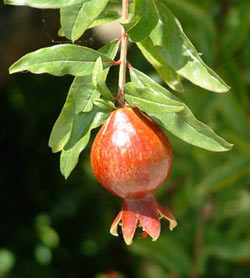The pomegranate fruit scientific
name Punica granatum is named after the ancient Phoenicians
(Punica) who were responsible for spreading the seeds/grain
(granatum) throughout the Mediterranean. The deciduous small
tree with many spring branches grows to about 15-18’.
It is native to semi-tropical Asia, Persia and Northern India.
Although it is now widely cultivated around the world in semi-arid
areas. In the Caribbean and other warm areas of Central America
the pomegranate is virtually unknown and can only be found in
Botanical Gardens and in yards of fruit enthusiast.
In the capital city, Belmopan, a consistently bearing tree
resides at the entrance of Angelus Press. The trees at Dem Dats
Doin were grown in enhanced acidic soil. They did very well
and bore fruit but after about seven years it went dormant and
never recovered. We believe the excessive rains of Toledo contributed
to its demise. The trees growing at Dem Dats Doin and Haney
Farms were from the fruits taken from Belmopan. The trees planted
at Haney Farms are in fertile loamy soil with good drainage
started to flower and fruit within two years.
|





